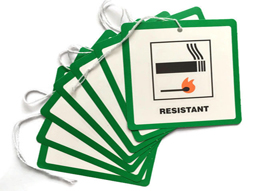
Polyurethane foam: fire safety, flammability and industry standards

Flammability performance is an important characteristic for foam products, particularly in relation to foam that is used in home furnishings, the automotive sector and in aircraft applications. Developed from a combination of organic chemicals, polyurethane foam must be carefully protected and handled in relation to all sources of ignition.
In summary, the Furniture and Furnishings (Fire Safety) Regulations act states that: All materials used for upholstery must be cigarette resistant and the covers match resistant; all filling materials must adhere to ignition standards; that a display label must be fitted to every new item of furniture upon sale (exclusions apply for second-hand furniture) and; that a five-year record of compliance must be maintained by the initial supplier of domestic upholstered furniture.
All manufacturers have a duty to ensure that the foam products they develop adhere to both local and international government fire regulations. In the UK, it is the Furniture and Furnishings (Fire Safety) Regulations that outline the set levels of fire resistance needed for all upholstered furniture, furnishings and other products containing upholstery - including polyurethane foam. There are a number of testing requirements that foam manufacturers must satisfy if their product is to be legally used in any type of furniture product. However, it is the joint responsibility of all furniture manufacturers, importers and retailers in the UK to ensure that furniture is not supplied to the general public containing foam fillings that do not adhere to the legal requirements.
There has been a longstanding relationship between private bodies and government organisations in order to help develop suitable, up-to-date guidelines for foam and upholstery products. For example, members of the PFA (Polyurethane Foam Association) have assisted with research into improving the combustion characteristics of Flexible Polyurethane Foam since the early 1960s, in order to help minimise both the combustion and ignition properties of foam and associated products. 2006 saw the PFA take an active role in supporting the U.S Consumer Product Safety Commission (CPSC) in achieving compulsory fire performance criteria for mattresses, and in 2007, the federal Open-Flame Mattress Standard (16 CFR Part 1633) came into action. However, regulatory policies do not solely apply to consumer upholstery products - the Federal Aviation Society (FAA) demands that fire safety is, in fact, the highest priority for aircraft upholstery. To meet composite flammability requirements, foam used in such applications must be accompanied by a fire-block fabric or have been treated with combustion-modifying additives during the production process.

With this in mind, it's interesting to note that the fire retardance of foam can also be altered by using different formulations of chemical additives to increase the fire resistance of polyurethane. Though polyurethane is often specifically produced in such a way to increase fire safety within a building, foam can be treated with chemical flame retardants to further increase its resistance to ignition.
For more information about eFoam's product flammability standards, please email one of our expert representatives.

